2007 GMC SIERRA CLASSIC service
[x] Cancel search: servicePage 423 of 674
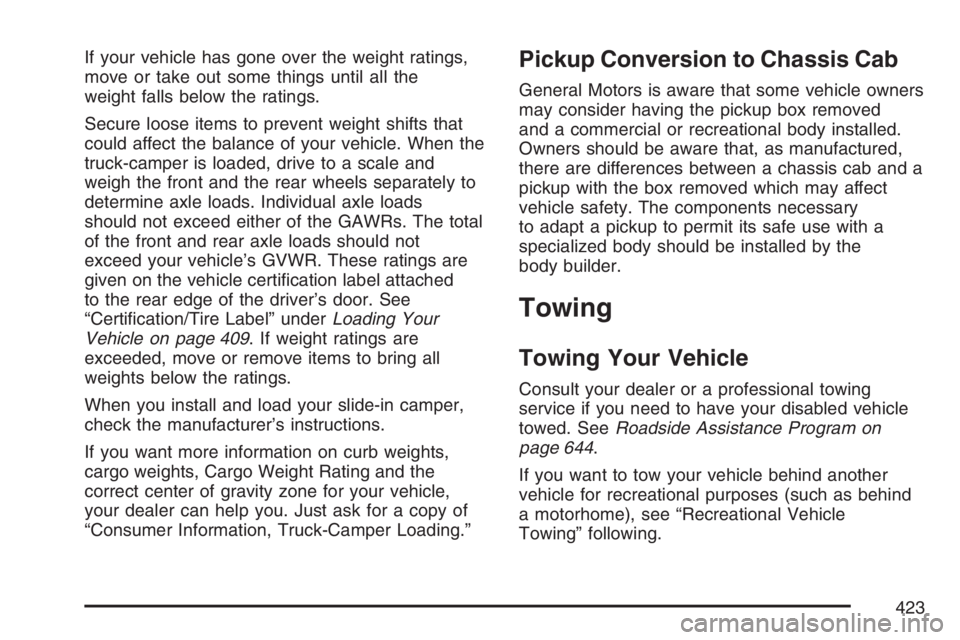
If your vehicle has gone over the weight ratings,
move or take out some things until all the
weight falls below the ratings.
Secure loose items to prevent weight shifts that
could affect the balance of your vehicle. When the
truck-camper is loaded, drive to a scale and
weigh the front and the rear wheels separately to
determine axle loads. Individual axle loads
should not exceed either of the GAWRs. The total
of the front and rear axle loads should not
exceed your vehicle’s GVWR. These ratings are
given on the vehicle certi�cation label attached
to the rear edge of the driver’s door. See
“Certi�cation/Tire Label” underLoading Your
Vehicle on page 409. If weight ratings are
exceeded, move or remove items to bring all
weights below the ratings.
When you install and load your slide-in camper,
check the manufacturer’s instructions.
If you want more information on curb weights,
cargo weights, Cargo Weight Rating and the
correct center of gravity zone for your vehicle,
your dealer can help you. Just ask for a copy of
“Consumer Information, Truck-Camper Loading.”Pickup Conversion to Chassis Cab
General Motors is aware that some vehicle owners
may consider having the pickup box removed
and a commercial or recreational body installed.
Owners should be aware that, as manufactured,
there are differences between a chassis cab and a
pickup with the box removed which may affect
vehicle safety. The components necessary
to adapt a pickup to permit its safe use with a
specialized body should be installed by the
body builder.
Towing
Towing Your Vehicle
Consult your dealer or a professional towing
service if you need to have your disabled vehicle
towed. SeeRoadside Assistance Program on
page 644.
If you want to tow your vehicle behind another
vehicle for recreational purposes (such as behind
a motorhome), see “Recreational Vehicle
Towing” following.
423
Page 456 of 674
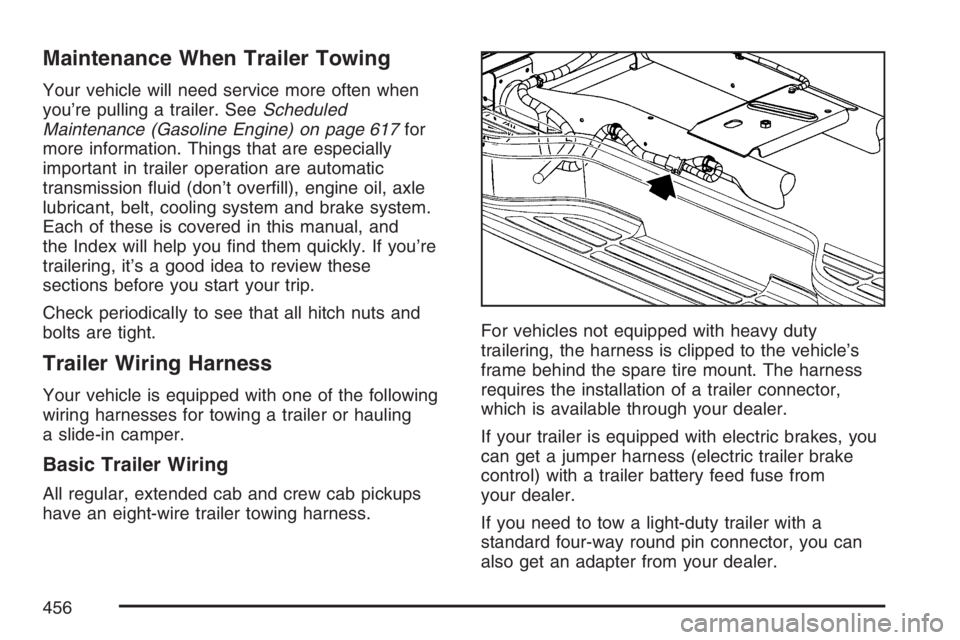
Maintenance When Trailer Towing
Your vehicle will need service more often when
you’re pulling a trailer. SeeScheduled
Maintenance (Gasoline Engine) on page 617for
more information. Things that are especially
important in trailer operation are automatic
transmission �uid (don’t over�ll), engine oil, axle
lubricant, belt, cooling system and brake system.
Each of these is covered in this manual, and
the Index will help you �nd them quickly. If you’re
trailering, it’s a good idea to review these
sections before you start your trip.
Check periodically to see that all hitch nuts and
bolts are tight.
Trailer Wiring Harness
Your vehicle is equipped with one of the following
wiring harnesses for towing a trailer or hauling
a slide-in camper.
Basic Trailer Wiring
All regular, extended cab and crew cab pickups
have an eight-wire trailer towing harness.For vehicles not equipped with heavy duty
trailering, the harness is clipped to the vehicle’s
frame behind the spare tire mount. The harness
requires the installation of a trailer connector,
which is available through your dealer.
If your trailer is equipped with electric brakes, you
can get a jumper harness (electric trailer brake
control) with a trailer battery feed fuse from
your dealer.
If you need to tow a light-duty trailer with a
standard four-way round pin connector, you can
also get an adapter from your dealer.
456
Page 459 of 674
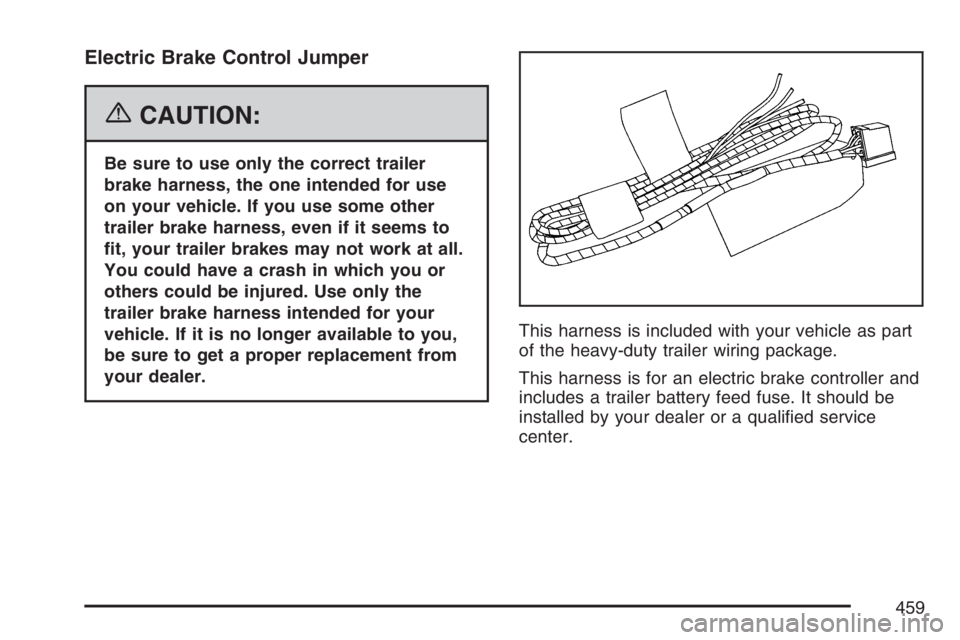
Electric Brake Control Jumper
{CAUTION:
Be sure to use only the correct trailer
brake harness, the one intended for use
on your vehicle. If you use some other
trailer brake harness, even if it seems to
�t, your trailer brakes may not work at all.
You could have a crash in which you or
others could be injured. Use only the
trailer brake harness intended for your
vehicle. If it is no longer available to you,
be sure to get a proper replacement from
your dealer.This harness is included with your vehicle as part
of the heavy-duty trailer wiring package.
This harness is for an electric brake controller and
includes a trailer battery feed fuse. It should be
installed by your dealer or a quali�ed service
center.
459
Page 465 of 674

Service........................................................ 468
Accessories and Modi�cations................... 468
California Proposition 65 Warning.............. 469
Doing Your Own Service Work.................. 469
Adding Equipment to the Outside of
Your Vehicle.......................................... 470
Fuel............................................................. 470
Gasoline Octane........................................ 470
Gasoline Speci�cations.............................. 471
California Fuel........................................... 471
Additives................................................... 472
Fuel E85 (85% Ethanol)............................ 473
Fuels in Foreign Countries........................ 474
Filling the Tank......................................... 474
Filling a Portable Fuel Container............... 477
Checking Things Under the Hood.............. 478
Hood Release........................................... 479
Engine Compartment Overview.................. 480
Engine Oil (Gasoline Engine).................... 486
Engine Oil Life System
(Gasoline Engine).................................. 489
Engine Air Cleaner/Filter
(Gasoline Engines)................................. 491Automatic Transmission Fluid
(Allison Transmission®) .......................... 494
Automatic Transmission Fluid
(Except Allison Transmission
®) ............... 497
Manual Transmission Fluid........................ 500
Hydraulic Clutch........................................ 501
Engine Coolant.......................................... 502
Coolant Surge Tank Pressure Cap............ 505
Engine Overheating................................... 505
Overheated Engine Protection
Operating Mode (V8 Engines Only)........ 508
Cooling System......................................... 508
Engine Fan Noise..................................... 514
Power Steering Fluid ................................. 515
Windshield Washer Fluid........................... 516
Brakes...................................................... 517
Battery...................................................... 520
Jump Starting............................................ 521
Rear Axle.................................................... 527
Four-Wheel Drive........................................ 528
Front Axle................................................... 529
Section 5 Service and Appearance Care
465
Page 466 of 674
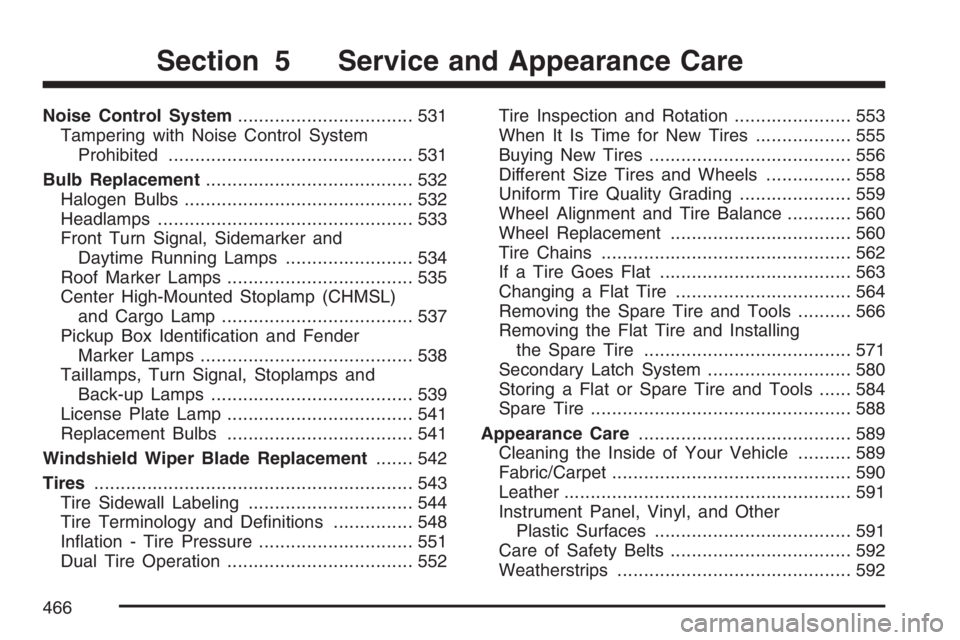
Noise Control System................................. 531
Tampering with Noise Control System
Prohibited.............................................. 531
Bulb Replacement....................................... 532
Halogen Bulbs........................................... 532
Headlamps................................................ 533
Front Turn Signal, Sidemarker and
Daytime Running Lamps........................ 534
Roof Marker Lamps................................... 535
Center High-Mounted Stoplamp (CHMSL)
and Cargo Lamp.................................... 537
Pickup Box Identi�cation and Fender
Marker Lamps........................................ 538
Taillamps, Turn Signal, Stoplamps and
Back-up Lamps...................................... 539
License Plate Lamp................................... 541
Replacement Bulbs................................... 541
Windshield Wiper Blade Replacement....... 542
Tires............................................................ 543
Tire Sidewall Labeling............................... 544
Tire Terminology and De�nitions............... 548
In�ation - Tire Pressure............................. 551
Dual Tire Operation................................... 552Tire Inspection and Rotation...................... 553
When It Is Time for New Tires.................. 555
Buying New Tires...................................... 556
Different Size Tires and Wheels................ 558
Uniform Tire Quality Grading..................... 559
Wheel Alignment and Tire Balance............ 560
Wheel Replacement.................................. 560
Tire Chains............................................... 562
If a Tire Goes Flat.................................... 563
Changing a Flat Tire................................. 564
Removing the Spare Tire and Tools.......... 566
Removing the Flat Tire and Installing
the Spare Tire....................................... 571
Secondary Latch System........................... 580
Storing a Flat or Spare Tire and Tools...... 584
Spare Tire................................................. 588
Appearance Care........................................ 589
Cleaning the Inside of Your Vehicle.......... 589
Fabric/Carpet............................................. 590
Leather...................................................... 591
Instrument Panel, Vinyl, and Other
Plastic Surfaces..................................... 591
Care of Safety Belts.................................. 592
Weatherstrips............................................ 592
Section 5 Service and Appearance Care
466
Page 467 of 674

Washing Your Vehicle............................... 592
Cleaning Exterior Lamps/Lenses................ 593
Finish Care............................................... 593
Windshield and Wiper Blades.................... 594
Aluminum or Chrome-Plated Wheels......... 594
Tires......................................................... 595
Sheet Metal Damage................................. 595
Finish Damage.......................................... 596
Underbody Maintenance............................ 596
Chemical Paint Spotting............................ 596
Vehicle Care/Appearance Materials............ 597
Vehicle Identi�cation.................................. 598
Vehicle Identi�cation Number (VIN)........... 598
Service Parts Identi�cation Label............... 598Electrical System........................................ 599
Add-On Electrical Equipment..................... 599
Windshield Wiper Fuses............................ 599
Power Windows and Other Power
Options.................................................. 599
Fuses and Circuit Breakers....................... 600
Instrument Panel Fuse Block..................... 600
Center Instrument Panel Fuse Block......... 602
Underhood Fuse Block.............................. 603
Capacities and Speci�cations.................... 609
Section 5 Service and Appearance Care
467
Page 468 of 674
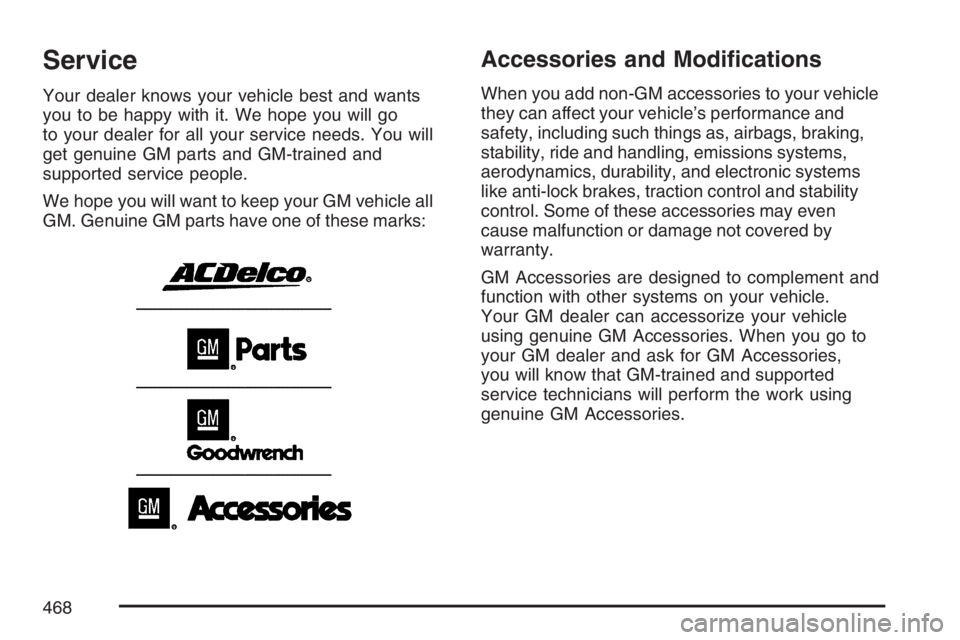
Service
Your dealer knows your vehicle best and wants
you to be happy with it. We hope you will go
to your dealer for all your service needs. You will
get genuine GM parts and GM-trained and
supported service people.
We hope you will want to keep your GM vehicle all
GM. Genuine GM parts have one of these marks:
Accessories and Modi�cations
When you add non-GM accessories to your vehicle
they can affect your vehicle’s performance and
safety, including such things as, airbags, braking,
stability, ride and handling, emissions systems,
aerodynamics, durability, and electronic systems
like anti-lock brakes, traction control and stability
control. Some of these accessories may even
cause malfunction or damage not covered by
warranty.
GM Accessories are designed to complement and
function with other systems on your vehicle.
Your GM dealer can accessorize your vehicle
using genuine GM Accessories. When you go to
your GM dealer and ask for GM Accessories,
you will know that GM-trained and supported
service technicians will perform the work using
genuine GM Accessories.
468
Page 469 of 674
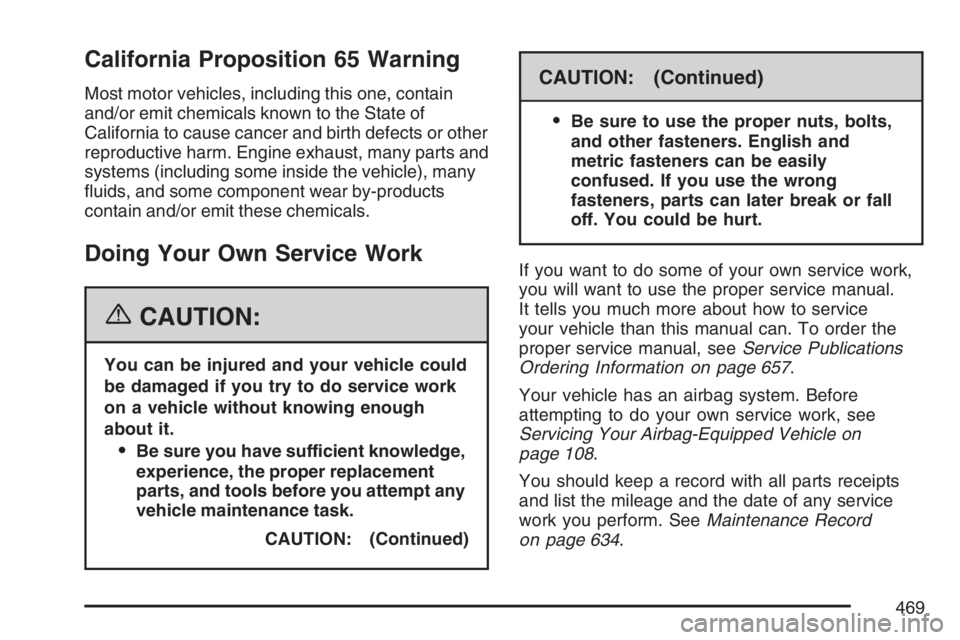
California Proposition 65 Warning
Most motor vehicles, including this one, contain
and/or emit chemicals known to the State of
California to cause cancer and birth defects or other
reproductive harm. Engine exhaust, many parts and
systems (including some inside the vehicle), many
�uids, and some component wear by-products
contain and/or emit these chemicals.
Doing Your Own Service Work
{CAUTION:
You can be injured and your vehicle could
be damaged if you try to do service work
on a vehicle without knowing enough
about it.
Be sure you have sufficient knowledge,
experience, the proper replacement
parts, and tools before you attempt any
vehicle maintenance task.
CAUTION: (Continued)
CAUTION: (Continued)
Be sure to use the proper nuts, bolts,
and other fasteners. English and
metric fasteners can be easily
confused. If you use the wrong
fasteners, parts can later break or fall
off. You could be hurt.
If you want to do some of your own service work,
you will want to use the proper service manual.
It tells you much more about how to service
your vehicle than this manual can. To order the
proper service manual, seeService Publications
Ordering Information on page 657.
Your vehicle has an airbag system. Before
attempting to do your own service work, see
Servicing Your Airbag-Equipped Vehicle on
page 108.
You should keep a record with all parts receipts
and list the mileage and the date of any service
work you perform. SeeMaintenance Record
on page 634.
469